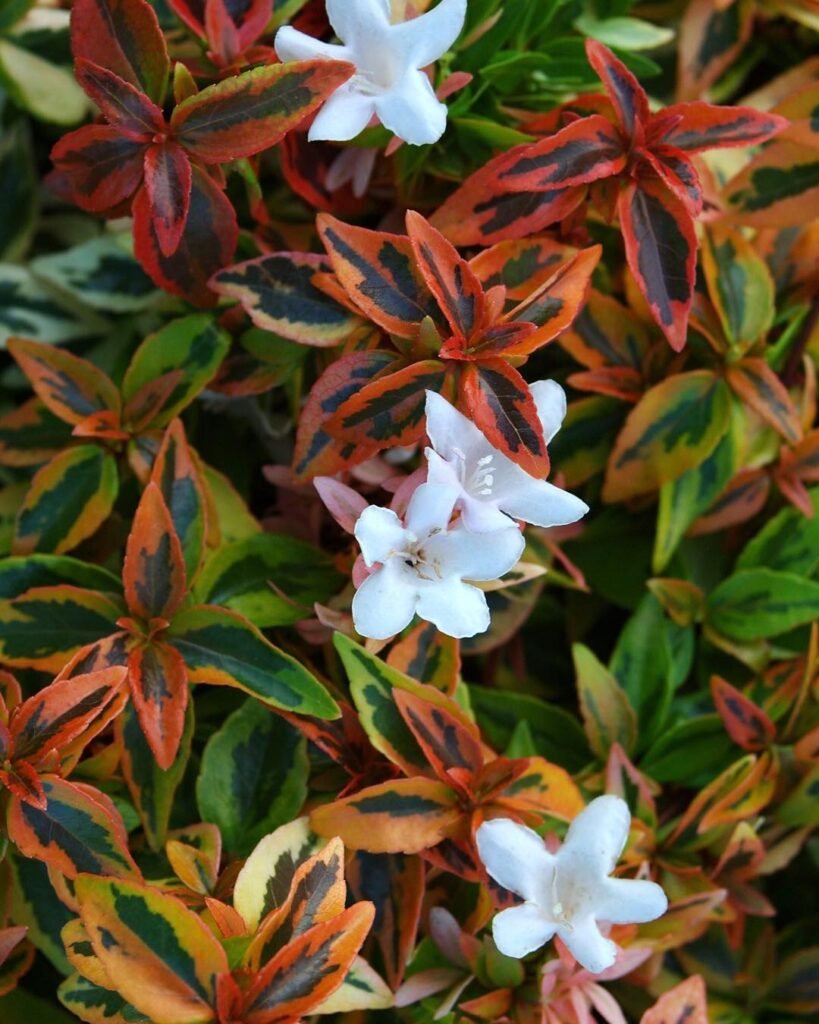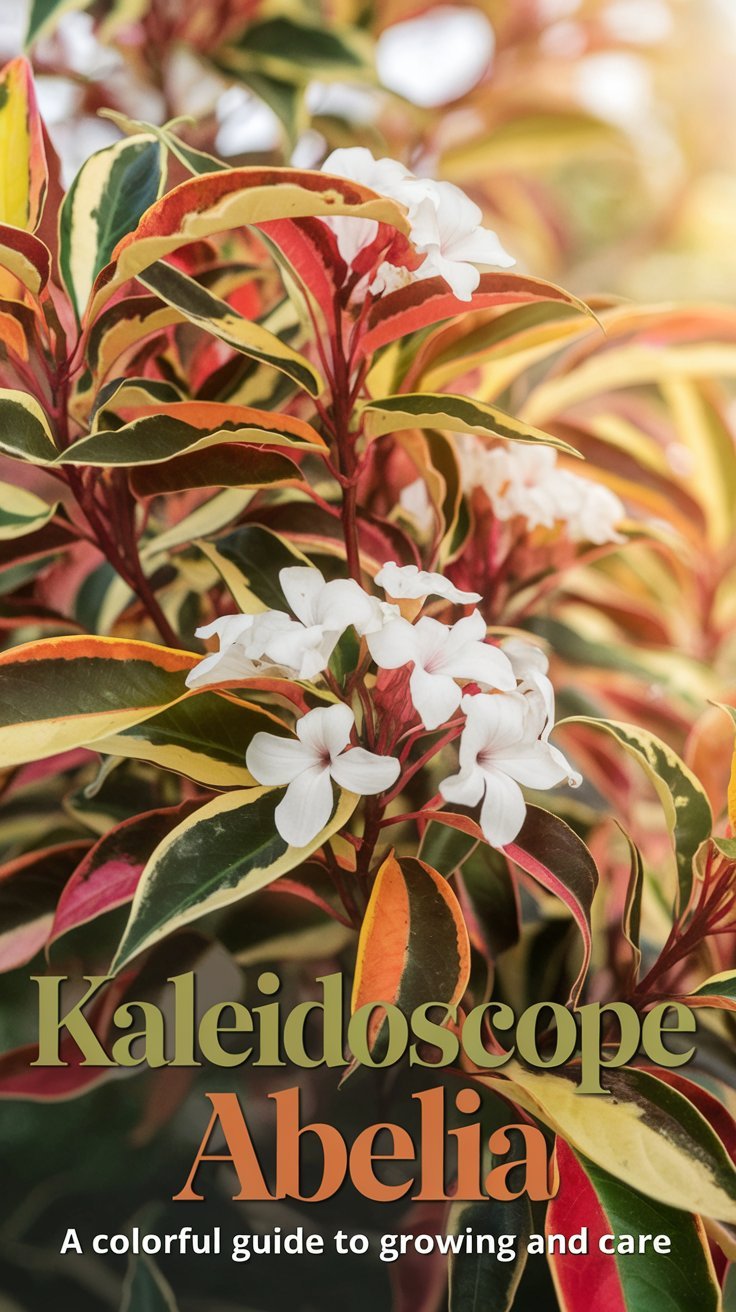Discover the vibrant world of Kaleidoscope Abelia – a stunning, low-maintenance shrub that brings year-round color to your garden. Learn expert tips on planting, care, and landscaping with this versatile cultivar.
Kaleidoscope Abelia (Abelia x grandiflora ‘Kaleidoscope’) is a stunning, compact shrub known for its ever-changing foliage colors throughout the seasons. This low-maintenance plant offers year-round interest with its variegated leaves that transition from green and yellow in spring to orange and red hues in fall and winter.

As a horticulturist with over two decades of experience, I’ve seen firsthand how Kaleidoscope Abelia can transform gardens with its vibrant display. Let me guide you through everything you need to know about this remarkable plant.
Quick Facts About Kaleidoscope Abelia

- Scientific Name: Abelia x grandiflora ‘Kaleidoscope’
- Plant Type: Evergreen or semi-evergreen shrub
- Mature Size: 2-3 feet tall and 3-4 feet wide
- Sun Exposure: Full sun to partial shade
- Soil Type: Well-draining, slightly acidic
- USDA Hardiness Zones: 6-9
Why Choose Kaleidoscope Abelia ?
Kaleidoscope Abelia offers numerous benefits for your landscape:
- Year-round color interest
- Drought-tolerant once established
- Attracts pollinators with its small, fragrant flowers
- Deer-resistant
- Low-maintenance
How to Plant Kaleidoscope Abelia
Best Time to Plant
Plant Kaleidoscope Abelia in spring or fall when temperatures are mild and rainfall is more frequent. This gives the roots time to establish before extreme weather conditions.
Planting Steps
- Choose a location with well-draining soil and appropriate sun exposure.
- Dig a hole twice as wide as the root ball and just as deep.
- Remove the plant from its container and gently loosen the roots.
- Place the plant in the hole, ensuring the top of the root ball is level with the soil surface.
- Backfill with soil, tamping down gently to remove air pockets.
- Water thoroughly after planting.
Care and Maintenance
Watering
- Water deeply and regularly during the first growing season to establish roots.
- Once established, Kaleidoscope Abelia is drought-tolerant but benefits from occasional deep watering during dry spells.
Fertilizing
- Apply a slow-release, balanced fertilizer in early spring.
- Avoid over-fertilizing, as this can lead to excessive foliage growth at the expense of the plant’s compact form.
Pruning
- Prune in late winter or early spring before new growth begins.
- Remove any dead, damaged, or crossing branches.
- Shape as desired, but avoid heavy pruning as it can reduce flowering.
Mulching
- Apply a 2-3 inch layer of organic mulch around the base of the plant, keeping it away from the stem.
- Mulch helps retain moisture, suppress weeds, and regulate soil temperature.
Landscape Uses
Kaleidoscope Abelia is versatile in the landscape:
- As a colorful border plant
- In mixed shrub beds
- As a low hedge
- In container gardens
- As a foundation planting
Common Problems and Solutions
Pests
Kaleidoscope Abelia is generally pest-resistant, but may occasionally face issues with:
- Aphids: Treat with insecticidal soap or a strong spray of water.
- Spider mites: Increase humidity and use miticides if necessary.
Diseases
- Root rot: Ensure well-draining soil and avoid overwatering.
- Leaf spot: Remove affected leaves and improve air circulation.
Seasonal Care Tips
Spring
- Prune as needed
- Apply fertilizer
- Monitor for new growth and adjust watering as needed
Summer
- Water deeply during dry spells
- Deadhead spent blooms to encourage more flowering
Fall
- Reduce watering as temperatures cool
- Enjoy the changing foliage colors
Winter
- Protect from harsh winds in colder zones
- Avoid pruning in late fall to prevent frost damage to new growth
Companion Plants
Kaleidoscope Abelia pairs well with:
- Ornamental grasses
- Coneflowers (Echinacea)
- Black-eyed Susans (Rudbeckia)
- Hostas (in partial shade settings)
Propagation
Kaleidoscope Abelia can be propagated through:
- Softwood cuttings in early summer
- Semi-hardwood cuttings in late summer
For best results, use rooting hormone and provide a humid environment for cuttings.
Frequently Asked Questions
- Is Kaleidoscope Abelia deer-resistant?
Yes, deer generally avoid Abelia plants, making them a good choice for gardens in deer-prone areas. - How fast does Kaleidoscope Abelia grow?
It has a moderate growth rate, typically growing 6-12 inches per year under ideal conditions. - Can Kaleidoscope Abelia be grown in containers?
Yes, its compact size makes it suitable for container gardening. Ensure the pot has adequate drainage holes. - Does Kaleidoscope Abelia lose its leaves in winter?
In warmer zones, it’s evergreen. In colder areas, it may be semi-evergreen, losing some leaves in harsh winters. - How often should I fertilize my Kaleidoscope Abelia?
Once in early spring with a slow-release fertilizer is usually sufficient. Over-fertilizing can lead to leggy growth.
Remember, while Kaleidoscope Abelia is generally low-maintenance, paying attention to its basic needs will reward you with a stunning, colorful display throughout the year. Happy gardening!
For more gardening tips and plant care guides, visit usagardenhub.com.


1 thought on “Kaleidoscope Abelia: A Colorful Guide to Growing and Care”